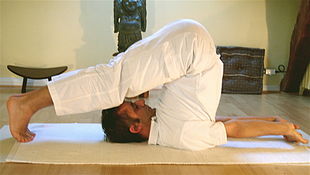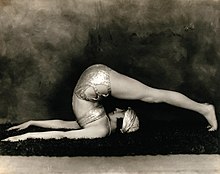Halasana
Its variations include Karnapidasana with the knees by the ears, and Supta Konasana with the feet wide apart.The name Halasana comes from Sanskrit हला hala, "plough" and आसन āsana, "posture" or "seat".[6] The pose is entered from Sarvangasana (shoulderstand), lowering the back slightly for balance, and moving the arms and legs over the head until the outstretched toes touch the ground and the fingertips, in a preparatory variant of the pose.The arms may then be moved to support the back into a more vertical position, giving a second variant pose.[10] All these variations may be performed as part of a cycle starting from Sarvangasana (Shoulderstand).



Sanskrithatha yogayoga as exerciseploughMarguerite AgnielJohn de MirjianSritattvanidhiSwami VishnudevanandaComplete Illustrated Book of YogaSivananda YogaB. K. S. IyengarLight on YogaSarvangasanaUpavistha KonasanaList of asanasYoga JournalIyengar, B. K. S.Light on Yoga: Yoga DipikaSjoman, Norman E.AsanasDrishtiPranayamaSun SalutationVinyasaYoga as therapyAnjaneyasana (crescent moon)Bidalasana (cat)/Bitilasana (cow)Bhujangasana (cobra)Chakrasana (wheel) or Urdhva Dhanurasana (upward bow)Viparita Dandasana (inverted staff)Kapotasana (pigeon)Eka Pada Rajakapotasana (king pigeon)Ushtrasana (camel)Ashtavakrasana (8-angled)Bakasana (crane) or Kakasana (crow)Koundinyasana (the sage Kaundinya)Kukkutasana (cockerel)Mayurasana (peacock)Tittibhasana (firefly)Adho Mukha Svanasana (downward dog)Adho Mukha Vrkshasana (handstand)Sarvangasana (shoulderstand)Setu Bandha Sarvangasana (bridge)Shirshasana (headstand)Viparita Karani (legs up the wall)Vrischikasana (scorpion)Anantasana (Vishnu's couch)Ashtanga Namaskara (eight-limbed)Bhekasana (frog)Chaturanga Dandasana (low plank)Dhanurasana (bow)Jathara Parivartanasana (belly twist)Makarasana (crocodile)Matsyasana (fish)Shalabhasana (locust)Shavasana (corpse)Vasishtasana (side plank)Yoganidrasana (yogic sleep)MeditationBaddha Konasana (cobbler)Gomukhasana (cow face)Gorakshasana (cowherd)Padmasana (lotus)Siddhasana (accomplished)Simhasana (lion)Vajrasana (thunderbolt)Bharadvajasana (the sage Bharadvaja)Marichyasana (the sage Marichi)Matsyendrasana (the sage Matsyendra, lord of the fishes)Pashasana (noose)Akarna Dhanurasana (shooting bow)Balasana (child)Garbha Pindasana (embryo in womb)Hanumanasana (monkey)Kraunchasana (heron)Kurmasana (tortoise)Malasana (garland)Mandukasana (frog)Mulabandhasana (root lock)Navasana (boat)Paschimottanasana (seated forward bend)Samakonasana (split)Virasana (hero)StandingParighasana (gate)Parshvottanasana (intense side stretch)Prasarita Padottanasana (wide stance forward bend)Tadasana (mountain)Trikonasana (triangle)Utkatasana (powerful)Uttanasana (standing forward bend)Utthita Parshvakonasana (sideways)Virabhadrasana (warrior)Ardha Chandrasana (half moon)Durvasasana (the sage Durvasa)Garudasana (eagle)Natarajasana (lord of the dance)Utthita Padangusthasana (standing big toe hold)Vrikshasana (tree)Standing asanasDownward dogLotus positionMeditation seatsTree poseWarriorNamasteVinyāsaHasta VinyasasTeacher trainingBritish Wheel of YogaEuropean Union of YogaAndré Van LysebethYoga AllianceTherapyYoga using propsAccessible yogaTrauma-sensitive yogaRestorative YogaYoga nidraInternational Association of Yoga Therapists • Richard MillerJanice GatesCompetitive yogaInternational Day of YogaAsana JournalYoga brickYoga mat